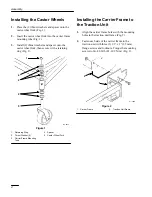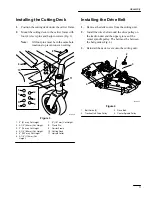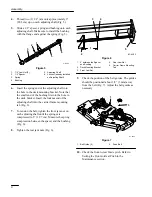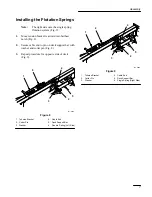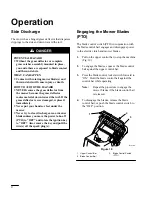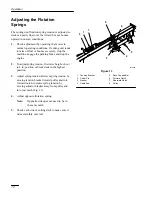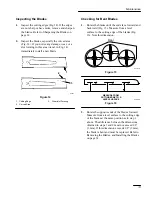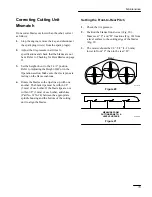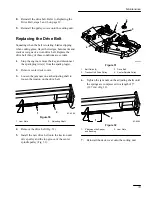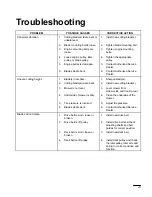
Maintenance
18
Adjust Idler Pulley
The idler pulley applies force against the belt so
power is transmitted to the blade pulleys. If the idler
is not properly tensioned, maximum power will not
be transmitted. Tension specification requires 25–30
ft. lb. (34–40.7 Nm) of torque on the idler adjusting
nut.
1.
Stop the engine, remove the key and disconnect
the spark plug wire(s) from the spark plug(s).
2.
Remove center covers from cutting unit.
3.
Loosen two (2) nuts securing idler plate
(Fig. 28).
4.
Using a socket and torque wrench, rotate the
idler adjusting nut until torque specification is
achieved (Fig. 28).
5.
Hold idler adjusting nut and tighten two (2) nuts
so idler plate is held securely. Release the idler
adjusting nut (Fig. 28).
6.
Install covers and secure latches.
2
3
1
M-4270
5
6
4
Figure 28
Top View
1.
Idler Arm
2.
Idler Adjusting Nut
3.
Nut
4.
Idler Plate
5.
Idler Pulley
6.
Deck Belt
Replacing the Deck Belt
Squealing when the belt is rotating, blades slipping
while cutting grass, frayed belt edges, burn marks and
cracks are signs of a worn deck belt. Replace the deck
belt if any of these conditions are evident.
1.
Stop the engine, remove the key and disconnect
the spark plug wire(s) from the spark plug(s).
2.
Remove all covers over pulleys.
3.
Remove the drive belt. Refer to Replacing the
Drive Belt, steps 1–4 on page 19.
4.
Loosen two nuts securing idler plate and pulley.
Then remove the worn deck belt (Fig. 29).
5.
Install the new deck belt around the two
outboard spindle pulleys, the idler pulley, and in
the lower groove of the center spindle pulley
(Fig. 29).
6.
With a torque wrench rotate the idler adjusting
nut until 25–30 ft. lbs. (34 – 40.7 Nm) of torque
is achieved (Fig. 28).
7.
Hold idler adjusting nut and tighten nuts so idler
plate is held securely (Fig. 28).
6
2
3
1
5
m-4257
4
Figure 29
Top View
1.
Idler Arm
2.
Center Spindle Pulley
3.
Outboard Spindle
Pulley (2)
4.
Drive Belt
5.
Idler Pulley
6.
Deck Belt

